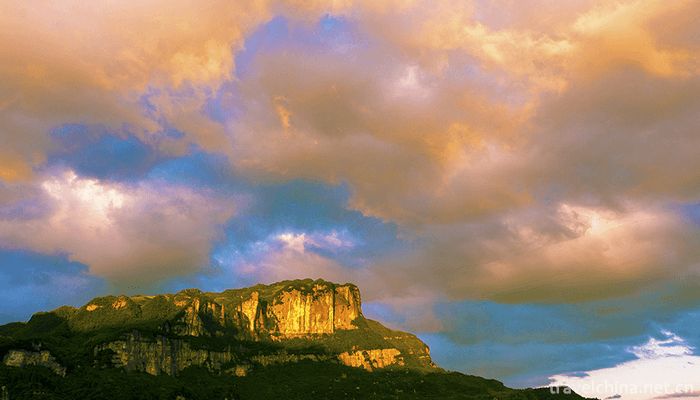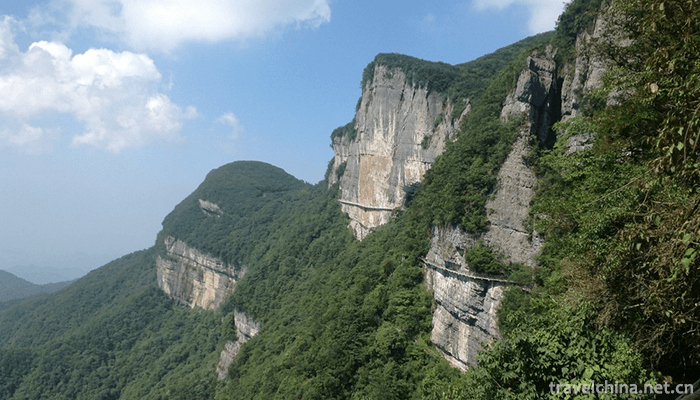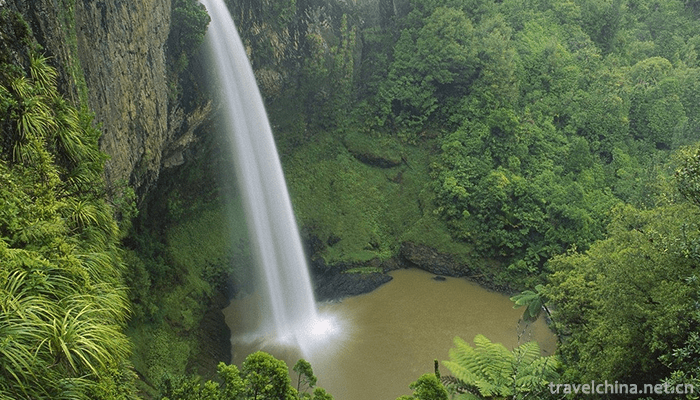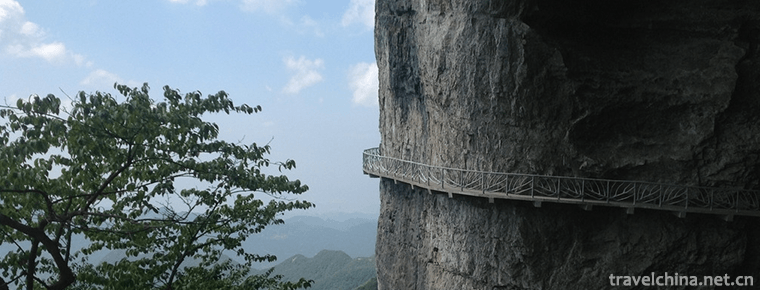Nanchuan Jinfo Mountain
Jinfo Mountain: World Natural Heritage, National AAAAA Tourist Scenic Spot, National Key Scenic Spots, National Forest Park, National Nature Reserve, National Natural Heritage, China's Most Influential Tourist Scenic Spot, China's Most Valuable Cultural (Heritage) Tourist Destination, National Civilized Tourism Scenic Spot, National Science Popularization Education Base, and "Emei Mountain, Qingcheng Mountain, Jinyun Mountain" Rong Four famous mountains in Lieba and Shu. Jinfo Mountain is located near 30 degrees north latitude in Nanchuan District of Chongqing City, north of Dalou Mountains, 32 kilometers from Baoxiang Temple of Nanchuan, 31 kilometers from Shenlong Gorge of Nanchuan, 210 kilometers from Gongtan Ancient Town, with an area of 1300 square kilometers, a scenic area of 441 square kilometers, a peak altitude of 2238 meters, and a forest coverage rate of more than 95%. It is known as "Natural Plant Showroom". "Golden Buddha He Cuiwei, among the misty clouds and clouds". When the summer and autumn evening is clear, the setting sun obliquely reflects the layers of the cliffs and dyes them golden and brilliant, such as a golden Buddha shining with thousands of rays, which is extremely magnificent and beautiful. "Golden Buddha Mountain" is named for it.
Jinfo Mountain is a typical karst geology and landform. The mountain is magnificent and beautiful, and the scenery is deep and charming. Peaks and valleys stretch over dozens of mountain ranges and stand over 100 steep peaks. Natural caves are scattered all over the area. The ancient Buddha cave located on the belly navel of the sleeping Buddha in the fuselage is the most famous one. It is large and deep. There are mountains, rivers and dams in the cave. There are holes in the cave, interlacing layers.
In the 250,000 Mu primitive evergreen forest of Jinfo Mountain, 2997 species of 237 families are collected. The scenic spot is known as the "Oriental Alps" because of its unique natural features, a wide variety of rare animals and plants, strange rock shape, mysterious and deep caves and palaces, unpredictable meteorological landscapes and monuments of famous temples.
Brief history of development
In 1988, Jinfoshan Scenic Area in Nanchuan District was approved as the second batch of national key scenic spots by the State Council.
In 1994, Jinfoshan Scenic Spot in Nanchuan District was rated as a national forest park by the State Forestry Administration.
In 1999, Jinfoshan Nature Reserve in Nanchuan District was named the first batch of national popular science education bases.
In 2000, the State Council approved the establishment of Jinfoshan National Nature Reserve.
In 2006, the Ministry of National Construction listed Jinfo Mountain in Nanchuan District as a national natural heritage.
In September 2006, Jinfoshan Scenic Spot began to develop as a whole. It has 12 scenic spots, such as Star Resort, Bitan Valley Scenic Spot, Petunia Ping Scenic Spot, Gaocaozi Scenic Spot and Yaochiba Scenic Spot.
In 2008, Jinfoshan Scenic Spot was selected as one of the twelve new sceneries in Bayu.
On May 1, 2009, the Bitan Valley Scenic Area, Shanxi Gate of Jinfo, was officially opened to the outside world for visitors.
On July 21, 2009, the Jinfo Mountain Cableway was officially opened to the outside world. Since then, the Jinfo Shanxi, South and North Tourist Ring Line has been fully connected.
Jinfoshan Scenic Spot is the only large-scale scenic spot in Chongqing that combines eight laurels, including World Natural Heritage, National Key Scenic Spots, National Forest Park, National Nature Reserve, the first batch of national popular science education bases, National Natural Heritage, National 5A Tourism Scenic Spot, China's most influential tourism scenic spot and National Civilized Tourism Scenic Spot.
In July 2011, Jinfo Mountain Scenic Area in Nanchuan District was awarded the honorary title of "Jinfo Mountain Literature Creation Base" by the Chinese Association of Post-90s Writers.
In June 2012, Jinfo Mountain officially launched the application work. On October 15 of the same year, Chongqing Jinfoshan, Guizhou Shibing, Guangxi Guilin and Pearl River were designated as the place of nomination for the second phase of "Southern China Karst" declaration by the state, and also the last batch of sites for the "Southern China Karst" heritage declaration project.
On November 15, 2012, Jinfo Mountain in Nanchuan District was officially awarded the title of "National Auto Driving Tour Base" and the first tourist scenic spot in Chongqing to win this honor.
On September 13, 2013, Nanchuan Jinfoshan United Shenlong Gorge Scenic Area was officially approved by the National Tourism Administration as the national AAAAA (5A) level scenic spot, becoming the sixth national 5A level tourist scenic spot in Chongqing.
On September 18, 2013, Jinfo Mountain in Nanchuan District was officially awarded the honorary title of "Photography Base of the Chinese Academy of Art Photography".
On April 8, 2014, the "World Wild Ancient Rhododendron Park Scenic Area" in Jinfo Mountain, Nanchuan District was officially opened to tourists.
On April 15, 2014, Jinfoshan Scenic Area of Nanchuan District was successfully selected as "Chongqing Bayu New 12 Scenic Spots" and "Chongqing Municipal Necessary Tourism Destination".
On June 15, 2014, at the 38th World Heritage Conference held in Doha, Qatar, the Kingfo Mountain scenic spot was successfully selected as the World Natural Heritage Site and included in the World Heritage List. Jinfoshan and Wulong belong to the same karst project in southern China. The number of world heritage sites in Chongqing has not increased.
In 2014, Jinfoshan Scenic Area in Nanchuan is actively declaring the honorary titles of "China National Geopark" and "National Geological and Geomorphological Nature Reserve".
On November 15, 2014, the "Jinfoshan" of Chongqing Rail Transit was officially opened. A mobile Jinfoshan will shuttle around the main city day and night.
On March 3, 2015, Nanchuan Jinfoshan Scenic Area was awarded the title of "National Civilized Tourism Scenic Area".
On May 24, 2015, Jinfo Mountain in Nanchuan District was awarded the title of "Famous Chinese Fitness Mountain".
On July 9, 2015, the Chinese representative of UNESCO awarded the bronze medal "Jinfo Mountain Karst and Cave Monitoring Test Station" to Jinfo Mountain Scenic Area in Nanchuan District.
In October 2015, the love film "Beijing meets Seattle's Love Letter" starring Wu Xiubo and Tang Wei, a well-known Chinese movie star, was filmed in the Jinfo Mountain Scenic Area as the only outdoor scene in China. The film was released nationwide on April 29, 2016.
On May 2, 2016, Nanchuan Jinfo Mountain Scenic Area successfully won the title of "China's most valuable cultural (heritage) tourism destination".
On January 17, 2017, Jinfoshan National Nature Reserve in Nanchuan District was awarded the title of "National Science Popular Education Base" again. It is the second national science education base awarded by the assessment and evaluation of the Chinese Association of Science and Technology. It is also the only one in Chongqing that has received two licenses from the Chinese Association of Science and Technology.
On February 8, 2018, the State Council agreed to adjust the scope of Jinfoshan National Nature Reserve in Chongqing. The area, scope and functional zoning of the adjusted protected areas shall be announced by the Ministry of Environmental Protection.
Geomorphologic climate
Jinfo Mountain is a typical karst geological landform. Because of its special geographical location and climatic conditions, it buffered the attack of Quaternary glaciers in ancient times. It has maintained the primitive natural ecology of the ancient and different geological ages. The mountains are magnificent and beautiful, and the scenery is deep and charming. Peaks and valleys stretch over dozens of mountain ranges and stand over 100 steep peaks. Natural caves are scattered all over the area. The ancient Buddha cave located on the belly navel of the sleeping Buddha in the fuselage is the most famous one. It is large and deep. There are mountains, rivers and dams in the cave. There are holes in the cave, interlacing layers.
Jinfo Mountain is a subtropical humid monsoon climate, with short winter, early spring, long summer, hot and rainy season, climate vertical change obvious characteristics. Because of the special climatic conditions, sometimes clouds and mists go, sudden arrival, the waves of the cloud sea roll over, and sometimes the rain passes through the sunshine. Clouds, rains, clouds, clouds, fogs, snow and wind form a unique and beautiful splendid meteorological landscape, forming a lot of beautiful water landscape, as well as three thousand feet of Longyan waterfall, Shuihuayan waterfall and three-layer waterfall.
Main landscape
Bitan Valley Scenic Area
Located in the west of the newly developed Jinfoshan National Scenic Spot, it belongs to the Xikou Canyon Ecotourism Scenic Spot. It is divided into five experiencing sections: the Gully Hearing Spring, the Stone Cliff Yichan, the Return and Come Garden, the Cliff Scenic Spot and the Geological Wonders. There are up to 100,000 negative oxygen ions per cubic centimeter, which is an excellent ecological place for lung washing, health and forest SPA. The Canyon in the scenic area is 3.5 kilometers long and takes about 90-120 minutes to visit. The scenic spot is primitive and mysterious, natural and natural, with exotic trees, immortal grasses, cliffs and rocks, waterfalls and springs, quiet and tranquil. Walking along the scenic spots, watching clouds, playing with water, appreciating stones and listening to springs, all the way, relaxed and happy.
The vegetation of Bitan Valley Scenic Area in Jinfo Mountain is lush and the forest coverage is 96%. The annual rainfall is about 1400 millimeters and the foggy day is about 260 days. The ice and snow period is from November to March of next year. In such a low latitude and low altitude area, there is such a snowfall period. It can be seen that the particularity of the regional climate here makes the Bitan Valley scenic spot no more hot summer. In the hottest season, the average temperature here will not exceed 20 C. It is an ideal summer resort.
Entering the Bitan Valley scenic area, the sound of the rippling water comes, clouds and mists dance in the mountains, walk along the wooden pavement in Finland, enjoy the wild flowers blooming one after another in the tree-shaded valley, listen to the mountains and springs, a school of tunes with the original scenery of the ghost monkeys in the mountains play with you skillfully and take pictures. Wild cherry blossoms in the jungle are blooming, a tree stretches out on the cliff, and the valleys are stacked in layers, sniffing in front of them, the fragrance of flowers pouring on their faces, and the blue birds are singing happily among the flowers in the mountains. The fragrance of the forest is mingled with the original flavor of Finnish wooden trestle road. Take a deep breath, with the fresh fragrance of green trees, grass and flowers, you instantly feel refreshed. Along the way, streams are accompanied by more intimate feelings of returning to the mother. A thatched cottage makes the place where the two streams converge a little bit Tai Chi, where the contemporary architecture integrated into nature becomes the highlight. Relying on the hut, listening to the bird's voice of Lin Tao, letting the gentle water mist brought by the wind touch the skin, returning to nature is the most simple act of inaction and laziness.
Bitan Valley Scenic Area, 10 years ago, is the favorite of Chongqing donkey friends
Special Recommendation: Camping Tent Hotel
Provide various kinds of tents, with multi-person (family) tents and double tents, etc., provide camping with their own tents. The tent area in the scenic area can accommodate 5000 people at the same time. Here, with beautiful scenery, beautiful mountains and rivers, tourists are in the embrace of nature, effectively absorbing the high content of negative oxygen ions in Jinfo Mountain.
The team area is located in Betula platyphylla lawn and morning glory grassland at the top of the mountain in the Star Resort.
The couples'area is set up in the scenic area.
Golden Foshan Cableway
Golden Foshan Cableway is a single-track circular detachable rope holder type. It is imported from France. The French Boma Company is responsible for the design, production and commissioning of a complete set of imported mechanical and electrical equipment. The cabin of the Cableway is not only beautiful in appearance, but also very safe and comfortable in the process of riding and running. The cableway is 2700 meters in length, 2500 meters in horizontal distance, 900 meters in vertical height, 15 brackets on the whole line, 700 kW in main driving power, 50 + 1 passenger lifting box on the whole line, 8 passengers per carriage, 6 meters per second in ropeway operation speed and 1400 passengers per hour in capacity.
Jinfoshan Cableway, with an investment of 110 million yuan, has been constructed for one year since it was officially started in August 2008. It was installed in mid-July 2009. On July 17, it passed the inspection and acceptance by the National Inspection and Inspection Center. It was officially operated outside the country on July 21, 2009. The daily operation time is 8:00-17:00.
Petunia Ping Scenic Area
Located at the top of the hill on the western slope of Jinfo Mountain, the scenic spots include Chaoyang, Jinfo Cave, Snow Playground, Phoenix Temple, Rhododendron King Tree, Primitive Forest, etc.
Walking on the Finnish wooden trestle road under the old trees and the sound of arrows and bamboo waves beating by the mountain wind, I personally experience the magical wind of Jinfo Mountain with the "five senses": listening to the sound of the wind, the charm of watching the wind, the smell of the wind, the taste of the wind, the spirit of catching the wind. Standing on the viewing platform of the cliff, we can look forward to the natural masterpiece of nature - the turtle chaoyang, the mountain shape like a tortoise waiting for thousands of years, stretching its neck to gaze at the sunrise and sunset, looking at the clouds, the Buddha light, and seemingly waiting for an agreement, or to greet someone's arrival. On the cliff wall beneath the tortoise, there are two naturally formed cliff caves, which are unexploited karst caves. There are free and spiritual rock swallows living inside. They chase clouds and fly together to add a lively atmosphere to the silent tortoise.
Gaocaozi Scenic Area
Located at the top of Jinfo Mountains, Qianniuping Scenic Area travels southward. The exotic peaks and cliffs formed by karst landform include: Shirenfeng, Nantianmen, Shimen Palace, Yinsha, Tongzi Baiguanyin, Triassic Waterfall, Mother and Son Peak, Yingzuiyan, Jinping Peak and other geological wonders.
Cableway Station Shirenfeng 4 km; Shirenfeng South Tianmen 2 km; South Tianmen Shimen Palace 2 km;
South Tianmen South Gate 4km
Jinshan Great Wall: Jinshan Great Wall is the most magnificent landscape of Jinfo Mountain and the origin of its name. In the past, the Great Wall of Jinshan could only be seen from a distance, and there was no way to go. After many visits, Chongqing Tourism Investment Group Landscape Metropolitan Company decided to build a trestle on the cliff, so that visitors can better appreciate the cliff and horizontal cave system of Jinfoshan.
The whole length of the trestle is actually 3.5 kilometers, of which 1.5 kilometers are almost built on a vertical 90-degree cliff wall, 40-50 meters from the ground. When walking, it feels like a slight step in the air, and feels frightened. This section is generally referred to as the cliff trestle. It is like a string of beads linking turtles Chaoyang, arrow bamboo sea, Lingguan Cave, ecological stone forest and other attractions. Among them, Swallow Cave is the ancient rock swallow habitat of dinosaurs at the same time. If the rock swallow goes out to forage or nest, visitors can see the spectacular scene of swallow flying together. Walking on the trestle road, traveling through clouds in foggy days and mountains in sunny days. It is the best place for viewing azaleas, colorful forests, sea of clouds and Buddha's light.
Another 2 kilometers, there is a kilometer close to the cliff wall circling upward, called hanging trail, can go from the cliff trestle road to the top of the mountain, and then into the ancient Rhododendron Park and ancient bamboo forest sea in Jinfo Mountain, this section is called forest trail. Walking along the forest trail, you can enjoy the azalea in spring and collect rare bamboo in autumn. Visitors are scarce in summer and winter, so you can recall the vicissitudes of life with these ancient cuckoos and bamboos alone. At the end of the Linzhong Trail is the Golden Buddha Temple, which is under construction. It is expected that the opening ceremony will be held in May next year. Through the cliff trestle road can also lead to the ecological stone forest, the Prince of Rhododendron, Yaochi Dam and other attractions.
Practical information
Admission ticket
90 yuan in peak season (January, February, July, August, November and December) and 70 yuan in off season (March, April, May, June, September and October). Jinfo west slope ropeway 50 yuan, 40 yuan down hill, 80 yuan round trip; north slope ropeway 40 yuan up hill, 30 yuan down hill, 70 yuan round trip.
Opening Hours
From 8:00 to 18:30, the cableway closes at 17:30 and the ticket stops at 16:00.
Surrounding scenic spots
Mazui, Jiudingshan City Park, Nanzhushan Forest Park, Huashan Park, Yonglong Mountain Park, Shanwangping, Shenlong Gorge, Tianxing Gorge, Tianxing Town, Lixianghu Lake, Longyan City, East Han Cliff Stone Carving, Yinzi Temple, etc.
Star rated hotel
Tianxing Liangjiang Holiday Hotel, Days Heng'an Hotel, Jinfoshan Hot Spring Hotel (under construction), Jinfoshan Holiday Hotel, Nanchuan Hotel, Jinchuan Hotel, Honesty Hotel, Xinhua Hotel, Tianhe Hotel, Yicheng Business Hotel, Jinfoshan Hotel, Lepusheng Hotel, Longcheng Hotel, Nanqiao Hotel, Win-win Hotel (under construction), Pujin Hotel Chenzhou Hotel (under construction), Jinjing Business Hotel, Fulbert Hotel, Kate Hotel
Four seasons scenery
Spring: All kinds of green surging, flourishing like the sea; Five-color azaleas, fighting for beauty.
Summer: Clouds, rains, clouds, clouds, clouds, clouds, clouds, clouds, clouds, clouds, clouds, clouds, clouds, clouds, clouds, clouds, clouds, clouds, clouds, clouds, clouds, clouds, clouds, clouds
Autumn: The autumn is high and refreshing, the layer forest is soaked, the bamboo shoots are strong and the rice is ripe, and the harvest is good.
Winter: Jade tree, Qionghua, silver wrapped in plain; Ice carved jade, Dragon Palace Scenic Spot.
Transport line
External traffic
Self driving
Self-driving route in Chongqing main urban area (about 1.5 hours):
North Slope:
Inner Ring Fast-Chongqing-Hunan Expressway (Boundary Stone) - Banan Station - Jinfoshan - via Provincial Highway 104 - Sanquan Town - Jinfoshan Slope
West Slope:
Inner Ring Fast-Chongqing-Hunan Expressway (Boundary Stone) -Banan Station-Nanchuan Interchange-Nanwan Expressway-Jinfo Shanxi-along the direction of Jinshan Town 413 Provincial Road-Sanhui-Shanxi Slope of Jinfo
Internal traffic
Public transportation
Four Kilometer Hub Station-Nanchuan Passenger Transport Center Station
Caiyuanba Bus Station-Nanchuan Passenger Transport Center Station
Longtousi Bus Station-Nanchuan Passenger Transport Center Station
Jiangbei International Airport-Nanchuan Passenger Transport Center Station
Longtou Temple Tourism Distribution Center-Jinfoshan Scenic Area
Caiyuanba Tourism Distribution Center-Jinfoshan Scenic Area
Nanchuan Passenger Transport Center Station-North Slope of Jinfo Mountain (Tourist Bus)
Nanchuan West Passenger Transport Station-Shanxi Slope of Jinfo (Tourist Bus)
Tourist through train
Caiyuanba Tourism Distribution Center-Jinfoshan Scenic Area
Note:
There are two stations in the urban area of Nanchuan, namely, the passenger transport center station and the passenger transport west station. The cars coming from the urban area of Chongqing go directly to the Nanchuan passenger transport center station.
The train from Nanchuan Passenger Transport Center Station arrives at the north slope of Jinfo Mountain and the train from Nanchuan Passenger Transport West Station arrives at the west slope of Jinfo Mountain.
From the passenger transport center station to the passenger transport west station, you can take a round-the-city bus for 5 yuan.
The self-contained tent area is located at the west gate of the scenic area.





-
1.White cut chicken
White cut chicken, also known as white cut chicken, is the most common dish in Guangdong cuisine. It is a kind of chicken dipping. Its characteristics are simple and easy to prepare, without batching
Time 2018-11-02 -
2.Yellow River Estuary Ecotourism Area
The Yellow River Estuary Ecotourism Area is located in the Yellow River estuary area of Dongying City, Shandong Province. It has unique ecotourism resources of the Yellow River Delta
Time 2019-01-18 -
3.Shui Dong gou
The Shuidonggou scenic spot in Ningxia is the earliest Paleolithic cultural site excavated in China. It is known as the birthplace of Chinese Prehistoric Archaeology
Time 2019-02-08 -
4.Hui folk instrumental music
Hui folk instrumental music is a long-term life practice and cultural activities of the Hui people in Ningxia, inheriting ancient instruments of Ningxia and northwest frontier fortress instruments and
Time 2019-05-04 -
5.Mongolian Sihu Music
Mongolian Sihu music is one of China's intangible cultural heritage. Mongolian Sihu is one of the most distinctive Mongolian musical instruments, stringed instruments.
Time 2019-06-04 -
6.Qingxu Caimen Building
Qingxu Caimen Tower is a local traditional handicraft in Qingxu County, Shanxi Province. Xu Caimen Tower in Qing Dynasty is said to have originated in Tang Dynasty. During the festival, people gathere
Time 2019-06-11 -
7.Production Techniques of Gold Bricks in Suzhou Royal Kiln
Royal kiln bricks production technology is complex, up to 20 processes, including the main processes of mud selection, mud drilling, billet making, kiln loading, firing, bass water, kiln out, grinding
Time 2019-06-17 -
8.Chengdu Sport University
Chengdu Institute of Physical Education is one of the six institutes directly under the former State General Administration of Sports. It is now a co-established Institute in Sichuan Province with the
Time 2019-08-31 -
9.Daci Temple
Daci Temple, also known as the ancient great saint CI temple, is located in the first section of Dongfeng Road, Jinjiang District, Chengdu City, Sichuan Province. It was built between the 3rd and 4th centuries AD, and is known as "the first jungle of the Sinian".
Time 2020-11-05 -
10.Erwang Temple
The Erwangmiao ancient building complex is located at the foot of Yulei mountain outside the west gate of today's Dujiangyan, which is an important part of the world cultural heritage Dujiangyan. The temple was built in memory of Li Bing and his son Erlang. The Erwang temple was first built in the northern and Southern Dynasties
Time 2020-11-08 -
11.Meishan water resources
There are 27887 water conservancy projects in Meishan City; there are 15 rivers with a drainage area of more than 100 square kilometers. Among them, Minjiang River flows through Pengshan, Meishan and Qingshen counties from north to south, with an internal flow length
Time 2020-12-18 -
12.Dazhou Railway
Railway lines: Chengdu Chengdu Railway, Xiangyang Chongqing railway, Dazhou Wanzhou railway, Daba railway and Chengdu Dazhou Wanzhou high speed railway (planned)
Time 2020-12-20